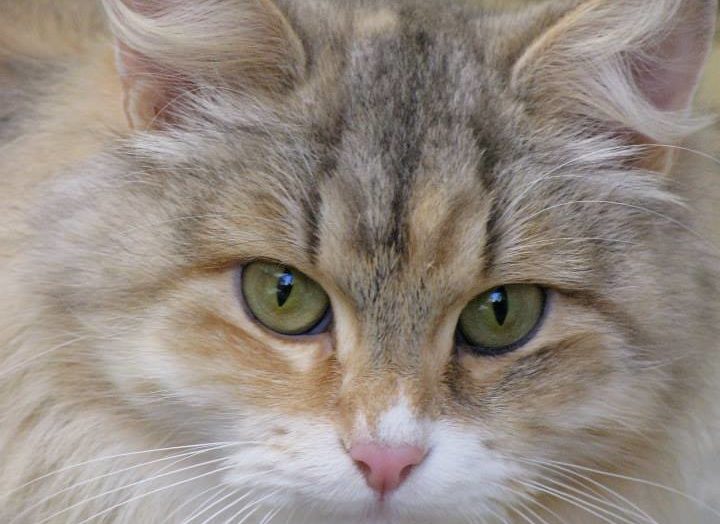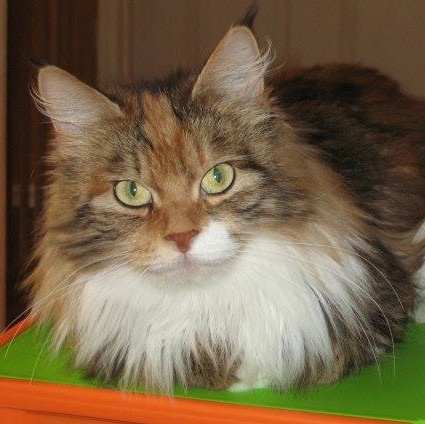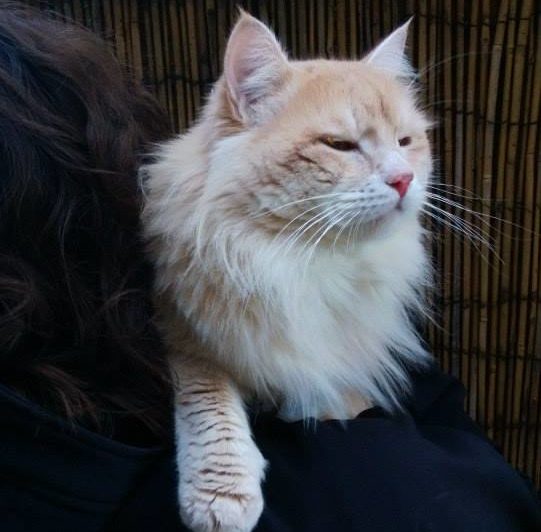The Siberian Forest Cat
Siberian cats are a playful breed well known for their hypo-allergenic fur and their uncanny dog like attributes. Owners of Siberians find that they are also playful, energetic and full of purr-sonality!
Allergies to cats are caused by the protein FEL-D1, which is transmitted to humans via the saliva on cat hair. Siberian’s have very little of this protein. Many people with cat allergies find they are able to interact with Siberian’s without any adverse affects.
Siberian cats are medium to large size (the males are typically larger than the females) and grow moderately long hair in a variety of colours and patterns. Maturity can take up to five years. Their features are rounded, as opposed to the angular features of other species, with a sweet but alert facial expression and large, almost almond eyes.
The affectionate, intelligent, loyal qualities of the Siberian have led to comparisons with a dog. Physically, they are strong, powerful and very agile. Unlike other breeds, Siberian’s are fascinated by water and have an inquisitive nature. Siberian cats have a triple purr and make a chirping sound when they greet you. They are good with children and adjust well to other pets, making them the ideal family animal.
The Siberian cat is believed to have originated in Russia and first appeared in documented history in the year 1000AD. They were first imported to the United States in 1990, and then to Australia in 2002.

History of the Siberian Forest Cat
The Siberian breed of cat originated in the ancient Russian forests of Siberia, where many of these beautiful animals still roam free today. Despite their prevalant, Siberians were valued and prized as pets in Russia because of their loyalty and charistmatic personality. Siberian’s feature in many Russian fairy tales as protectors of children.
The then Soviet Union first registered the breed with a felinological organisation in 1989. They were so-called due to their thick, water proof hair, associated with the unforgiving winters of Siberia. Furthermore, ‘Siberian cat’ was the traditional Russian name for any big, furry cat.
While Russians have bred Siberians for centuries, the breed first became known to the rest of the world in 1871, when Harrison Weir authored the first pedigree cat book. Siberians were first exported in the 1990’s after the fall of Communism, and began entering Australian homes in 2002.

Siberian Cats are Hypo-Allergenic
Siberian cats are renowned amongst cat owners for their limited ability to produce reactions with people suffering cat allergies. Many allergy sufferers find that Siberian’s are the only cats that they can interact with.
Allergic reactions are caused not by cat hair, as is the popular belief, but by a glyco-protein called Fed d1. Fed d1 is produced by a cats skin glands, saliva and urine. When cats groom themselves, the saliva mixes with dead skin, which becomes airborne. These dead skin particles are so tiny that they often bypass air filtration systems. Allergic reactions are triggered by contact with these particles. Reactions can include sneezing, throat irritations, a skin rash and difficulty breathing.
Siberian’s produce less Fed d1 than other species of household cat. There is also evidence that the characteristic thick, tight undercoat and oily top coat of the Siberian produces less dander (dead skin.) While there is no definitive proof or reason for the hypo allergenic qualities of the Siberian, anecdotal evidence from owners of Siberian’s suggest that this breed causes little to no reaction with allergy sufferers.
The Siberian is, on experience, a hypo-allergenic breed at the very least. There is much less likelihood of an allergic reaction to this breed of cats. 30% of households in Australia have a cat as pet and cats are now more popular than dogs as pets there.
With so many people suffering allergic reactions to cats, a low allergy breed is the purrfect solution for many who would otherwise miss out on the pleasure of owning a cat.
A cat’s hair length has nothing to do with allergies. Allergic reactions are triggered by a glyco-protein (Fel d1) produced by the sebaceous glands of skin (all areas of the fur, particularly the neck), saliva and urine.
When cats groom, saliva mixes with dander (dead skin), which becomes airborne when dry and spreads around the house. These particles are small and usually cannot be removed by household air filters. The allergic reaction in humans is triggered by the contact of these particles with the skin or by inhalation of these particles. These reactions vary from red, itchy skin rash, through difficulty breathing, to sneezing, watery irritated eyes, scratchy throat and maybe an itchy, runny nose.
The hypo-allergenic qualities of the Siberian remain a bit of a mystery, and no theory about it has yet been medically or scientifically substantiated. Some theories speculate that Fel d1 levels are lower than the usual house cat, or absent completely.
Another theory suggests low dander production, due to the characteristic tight, thick undercoat and oily top coat. This is said to leave the skin moist and so lower the production and spread of dander. On the down side, if the allergy-sufferer is vulnerable to IgE late trigger antibody reaction, there is an increased risk of an allergic reaction, even to a beautiful Siberian. However, many people will testify that, while they are allergic to other cats, they are happily allergy-free with Siberians.
Appearance of the Siberian Cat
Siberian cats grow to a medium to large size, with the males typically larger than the females. They attain full growth more slowly than other cats, taking approximately five years to reach maturity. A full grown Siberian weighs, on average, 7 to 9 kilograms (15 to 20 pounds) for a female and 4.5 to 7 kilograms (10 to 15 pounds) for a male.
They have rounded features, compared to the angular features of other species, with a sweet and alert face and large, almond shaped eyes. They are known to have a strong and powerful build. The hind legs of the Siberian are slightly longer than their front legs, making them exceptionally high jumpers.
Siberian’s grow moderately long, textured fur. It is plush, generally tabby coloured and does not have a tendency to matt. Siberian’s usually have a range of colorations.

Temperament of Siberian Cats
Siberian’s are often called the dogs of the cat world, due to their devoted and loyal traits. This breed are incredibly affectionate and loving creatures who adore human contact, especially with children. They consider themselves lap cats and love being petted while curled up on their owners lap, but are also active and engaging animals who enjoy playing games.
Siberian’s are highly intelligent cats. They will come when you call and often seek out their owners for a ‘conversation’ with their chirp like voices. Siberian’s stick close to their owner when they are home and often greet them at the door. Owner’s find they are easily trained and respond to basic commands, much like a dog.
Siberians have an inquisitive nature and are fascinated by water. They are also confident, good natured and highly adaptable.
Breed Standard
SIBERIAN CAT BREED STANDARD
Siberians are one of the largest cats, about the same size as a Maine Coon, but more like a pet dog in personality, and more appealing. Its head is a large, rounded wedge shape, more circular than triangular. The beautiful Siberian is extremely loyal and affectionate.
RECOGNIZED CATEGORY / DIVISIONS/COLORS: Traditional Category, all Divisions, all colors.
GENERAL DESCRIPTION: Siberians are large and strong, taking about 5 years to fully mature, and the males are larger than the females. Their long, arched and slightly curved back appears straight when they’re moving and their powerful muscles make them very agile. They’re great at jumping and the muscles of their convex waist and compact belly develop with maturity. Their forelegs are slightly shorter than their hind. Large and powerful, their round paws add to their general appearance of size and strength when they are alert and in good condition. The impression of soft curves adds to the appeal of their facial expression, compared to the sharper, more angular look of similar breeds.
HEAD: The medium-sized head is broader at the skull, narrowing to a rounded muzzle and full chin. The top of the head is flat, leading to a slight curve before the tip of the nose. Slight curvature of the muzzle blends smoothly with the gentle transition from the side of the head, while the cheekbones are neither set high nor do they stand out. The strong, muscular neck is medium to long and rounded.
TAIL: Medium length, wide at the base, blunt-tipped. No kinks or ticking, with thick, even fur.
EARS: Wide, medium to large, set evenly between sides and top of head, ideally separated by 1-1.5 ear widths. Forward tilt and rounded, ideally Lynx-tipped. Hair is short and thin on the back of the ears, becoming longer through the middle, completely coating the base.
EYES: Wide-set, rounded eyes angle slightly towards the lower base of the ear at the corners. Eye-colour is typically yellow-green and is unrelated to coat colour or pattern.
COAT: Moderately long to long. Oily, lacquered appearance when ungroomed. Thicker and shorter on the shoulder blades and lower chest, with copious ruff. Close-knit undercoat thicker in winter than summer. Wavy coat unusual, but curls on belly and britches not so. Strong colours and defined patterns desirable, but secondary. Skin may have bluish tinge.
ALLOWANCES: buttons, spots or lockets.
PENALIZE: Underweight adults. Straight profile. Narrow or pointy muzzle. Almond shaped eyes. Very long legs.
VARIETIES: From Cat Fanciers Breed Standard – all colours possible. All colours accepted with or without white in Traditional class. In this class, blue golden is the same as golden with the tips blue rather than black. In Tabby, white/off white acceptable on chin, breast and stomach with buttons, spots and lockets acceptable in all colours. Pattern/colour descriptions same as for Persian. In Colorpoint, tortie, bicolour, mitted and lynx acceptable – mitted and bicolour descriptions same as for Ragdoll, tortie and lynx same as for Birman. No outcrosses acceptable for this breed.
PERSONALITY: Siberians are not shy or timid and aregreat companions, just like a dog – they’ll greet strangers and are very affectionate, with a triple purr and chirping sound when greeting you. They are fast learners, intelligent and well-able to get what they’re after. They answer to their name and their bushy stands erect and shimmers when they’re happy, which may look like spraying but isn’t. These cats are fascinated with water, inspecting not-quite-dry bathtubs and dropping toys into water dishes. An ideal lap cat, Siberians love to be spoken to and are very active when playing.